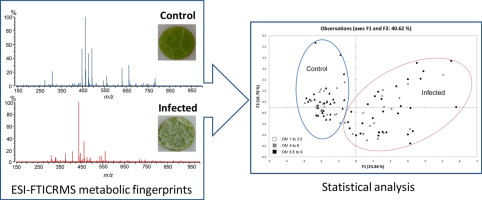Accueil du site > Production scientifique > Metabolic study of grapevine leaves infected by downy mildew using negative ion electrospray – Fourier transform ion cyclotron resonance mass spectrometry
Metabolic study of grapevine leaves infected by downy mildew using negative ion electrospray – Fourier transform ion cyclotron resonance mass spectrometry
Date de publication: 17 septembre 2013
Loïc Becker, Anne Poutaraud, Grégory Hamm, Jean-François Muller, Didier Merdinoglu, Vincent Carré, Patrick Chaimbault
Analytica Chimica Acta 795 44-51 (2013). DOI
Travail réalisé sur le site de l’Université de Lorraine.
Abstract

Grapevine is of worldwide economic importance due to wine production. However, this culture is often affected by pathogens causing severe harvest losses. Understanding host–pathogen relationships may be a key to solve this problem. In this paper, we evaluate the direct flow injection by electrospray – Fourier transform ion cyclotron resonance mass spectrometry (MS) of leaf extracts as a rapid method for the study of grapevine response to downy mildew (Plasmopara viticola) attack. The comparison of MS profiles obtained from control and infected leaves of different levels of resistant grapevines highlights several classes of metabolites (mainly saccharides, acyl lipids, hydroxycinnamic acids derivatives and flavonoids) which are identified using high resolution MS and tandem MS (MS/MS). Statistical analyses of 19 markers show a clear segregation between inoculated and healthy samples. This study points out relative high levels of disaccharides, acyl lipids and glycerophosphoinositol in inoculated samples. Sulfoquinovosyl diacylglycerols also emerge as possible metabolites involved in plant defense.








